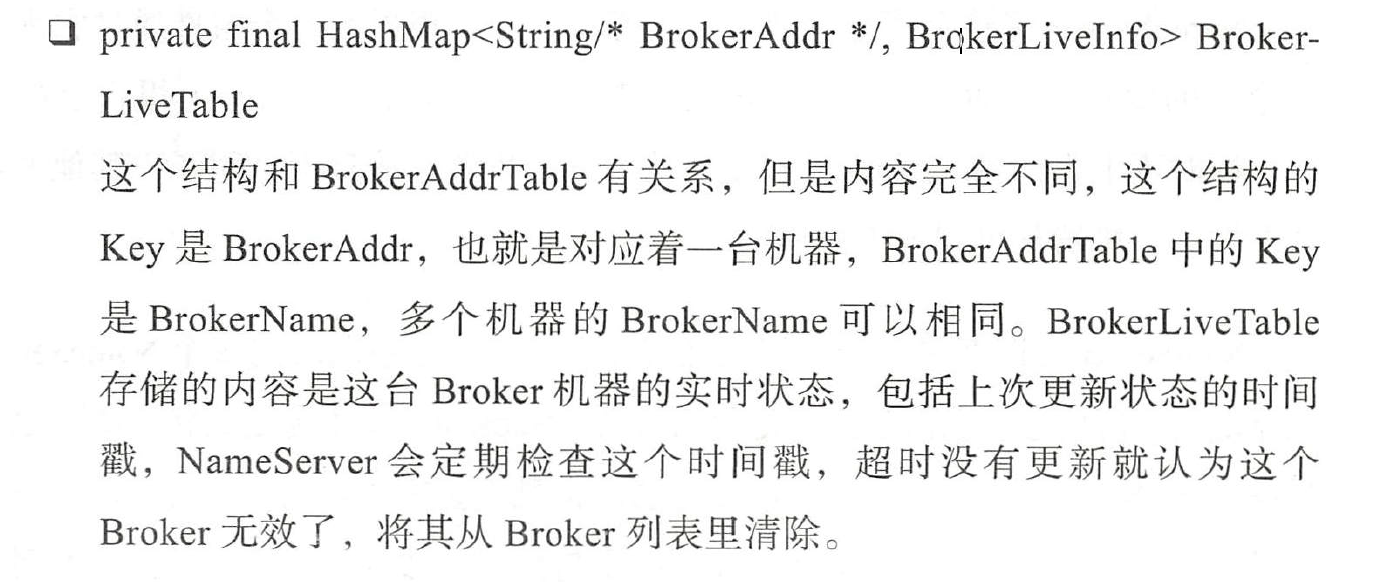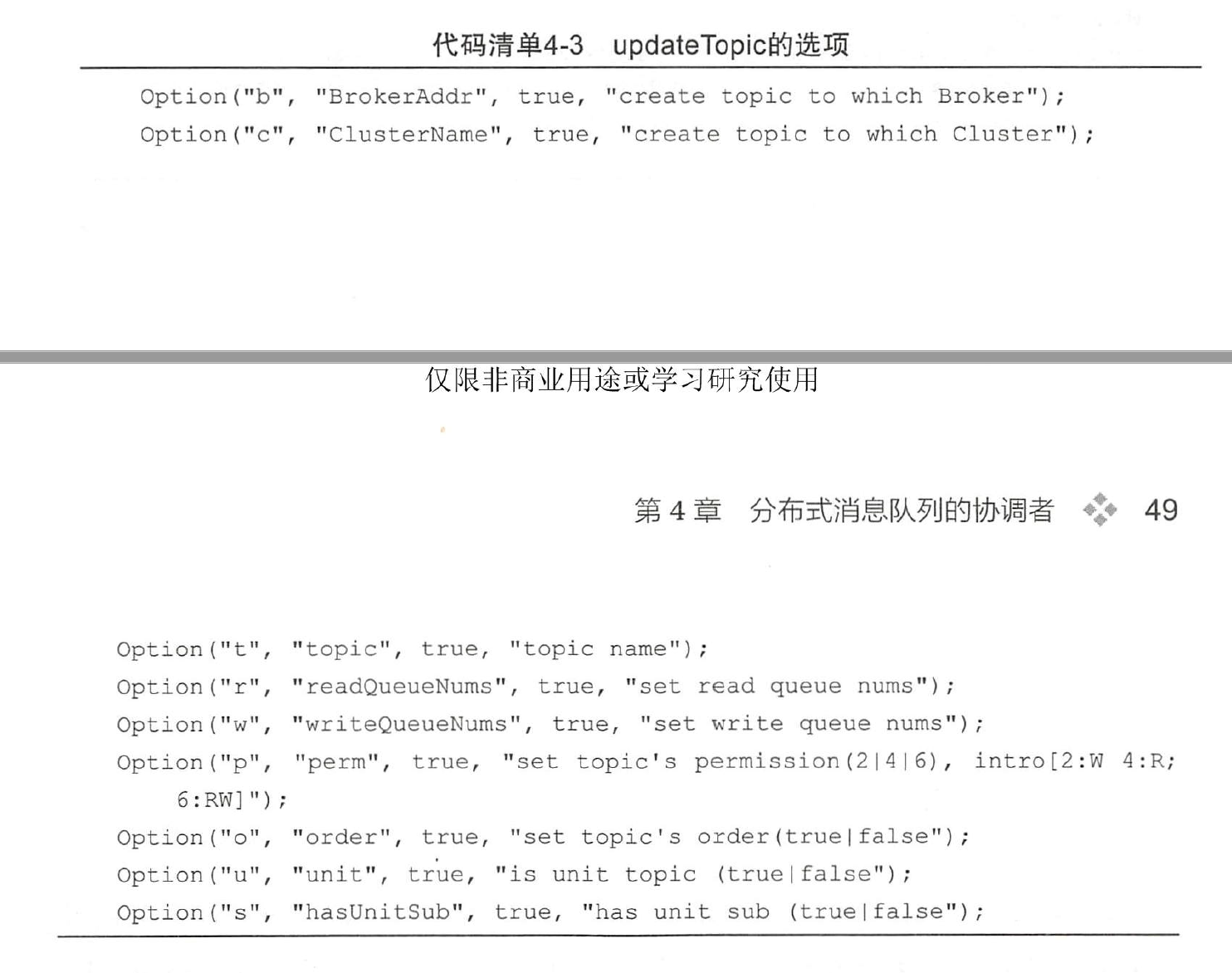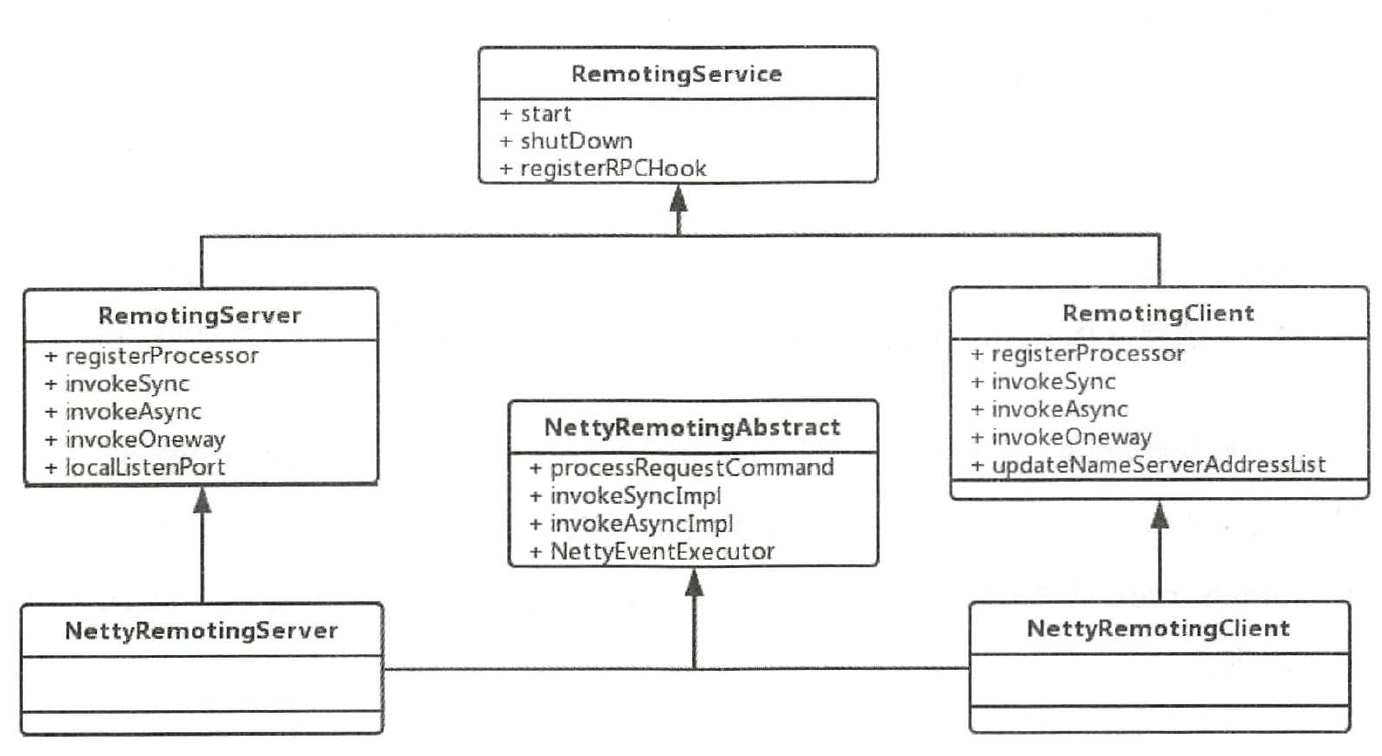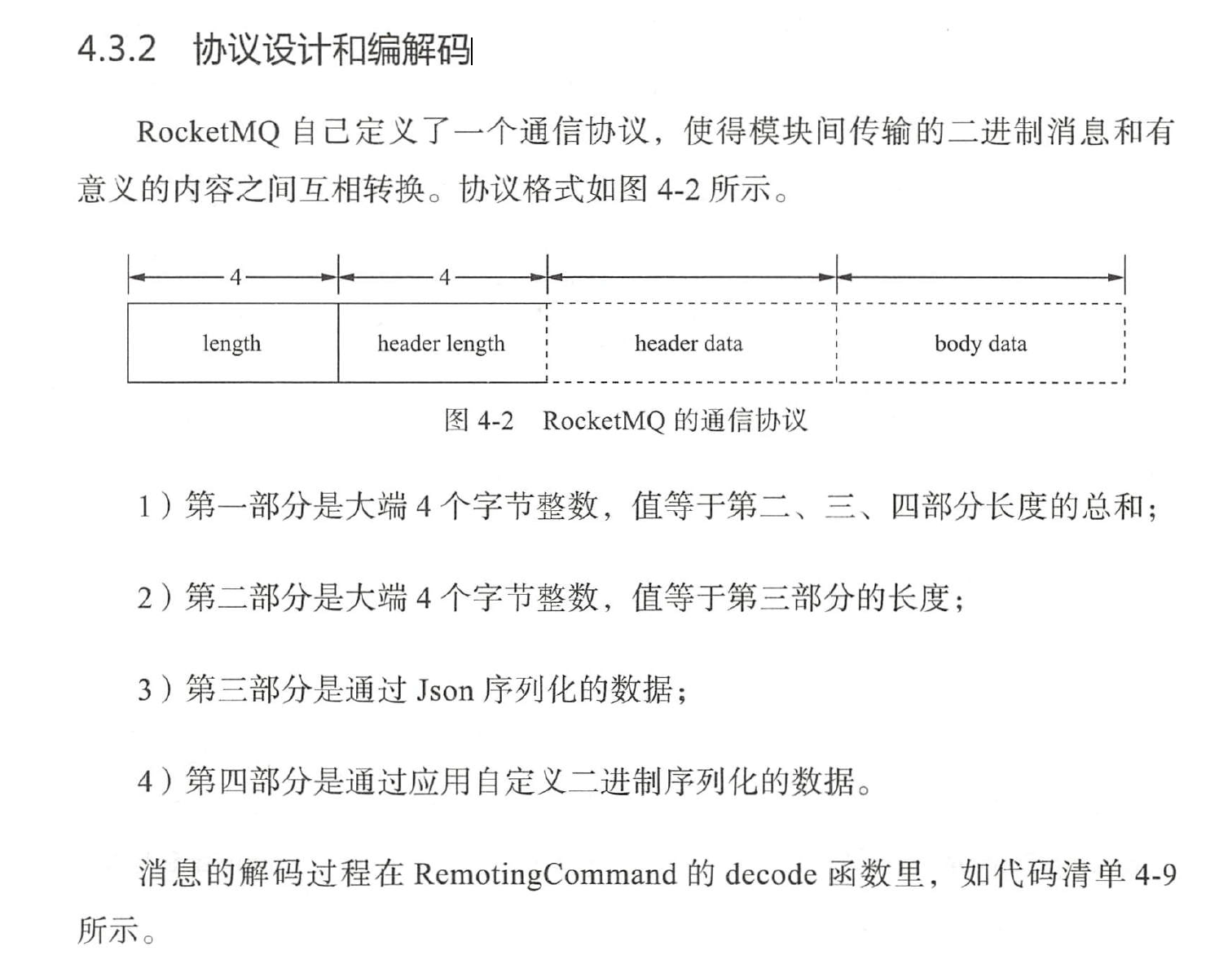4 分布式消息队列的协调者

NameServer的功能主要维护RouteInfoManager对象里的这5个状态
private final HashMap<String/* topic */, List<QueueData>> topicQueueTable; private final HashMap<String/* brokerName */, BrokerData> brokerAddrTable; private final HashMap<String/* clusterName */, Set<String/* brokerName */>> clusterAddrTable; private final HashMap<String/* brokerAddr */, BrokerLiveInfo> brokerLiveTable; private final HashMap<String/* brokerAddr */, List<String>/* Filter Server */> filterServerTable;
private final HashMap<String/* topic */, List<QueueData>> topicQueueTable;
public class QueueData implements Comparable<QueueData> { private String brokerName; private int readQueueNums; private int writeQueueNums; private int perm; private int topicSynFlag;

private final HashMap<String/* brokerName */, BrokerData> brokerAddrTable;
public class BrokerData implements Comparable<BrokerData> { private String cluster; private String brokerName; private HashMap<Long/* brokerId */, String/* broker address */> brokerAddrs;

private final HashMap<String/* clusterName */, Set<String/* brokerName */>> clusterAddrTable;

private final HashMap<String/* brokerAddr */, BrokerLiveInfo> brokerLiveTable;
class BrokerLiveInfo { private long lastUpdateTimestamp; private DataVersion dataVersion; private Channel channel; private String haServerAddr;

清除时间默认是120秒
private final HashMap<String/* brokerAddr */, List<String>/* Filter Server */> filterServerTable;

NameServer 如何维护各个Bro ker 的实时状态,如
何根据Broker 的情况更新各种集群的属性数据。因为其他角色会主动向
Name Server 上报状态,所以NameServer 的主要逻辑在DefaultRequestProcessor
类中,根据上报消息里的请求码做相应的处理, 更新存储的对应
信息。
连接断开的事件也会触发状态更新,具体逻辑在BrokerHousekeepingService类中

各个角色间的交互流程
updateTopic的选项


所以我们用producer发消息时写一个新的topic,这个topic会在该集群下的每个master broker下创建Message Queue。
创建一个topic的过程是,
client先构建CreateTopicRequestHeader,命令是UPDATE_AND_CREATE_TOPIC,发送给broker包
broker包下的AdminBrokerProcessor类接到命令后,先更新本地的topicConfig,之后添加REGISTER_BROKER命令,发送给NameSrv,
NameSrv包下的DefaultRequestProcessor类接到命令后执行RouteInfoManager的registerBroker方法,更新topic信息。
更新逻辑如下:

代码如下:
public RegisterBrokerResult registerBroker( final String clusterName, final String brokerAddr, final String brokerName, final long brokerId, final String haServerAddr, final TopicConfigSerializeWrapper topicConfigWrapper, final List<String> filterServerList, final Channel channel) { RegisterBrokerResult result = new RegisterBrokerResult(); try { try { this.lock.writeLock().lockInterruptibly(); Set<String> brokerNames = this.clusterAddrTable.get(clusterName); if (null == brokerNames) { brokerNames = new HashSet<String>(); this.clusterAddrTable.put(clusterName, brokerNames); } brokerNames.add(brokerName); boolean registerFirst = false; BrokerData brokerData = this.brokerAddrTable.get(brokerName); if (null == brokerData) { registerFirst = true; brokerData = new BrokerData(clusterName, brokerName, new HashMap<Long, String>()); this.brokerAddrTable.put(brokerName, brokerData); } Map<Long, String> brokerAddrsMap = brokerData.getBrokerAddrs(); //Switch slave to master: first remove <1, IP:PORT> in namesrv, then add <0, IP:PORT> //The same IP:PORT must only have one record in brokerAddrTable Iterator<Entry<Long, String>> it = brokerAddrsMap.entrySet().iterator(); while (it.hasNext()) { Entry<Long, String> item = it.next(); if (null != brokerAddr && brokerAddr.equals(item.getValue()) && brokerId != item.getKey()) { it.remove(); } } String oldAddr = brokerData.getBrokerAddrs().put(brokerId, brokerAddr); registerFirst = registerFirst || (null == oldAddr); if (null != topicConfigWrapper && MixAll.MASTER_ID == brokerId) { if (this.isBrokerTopicConfigChanged(brokerAddr, topicConfigWrapper.getDataVersion()) || registerFirst) { ConcurrentMap<String, TopicConfig> tcTable = topicConfigWrapper.getTopicConfigTable(); if (tcTable != null) { for (Map.Entry<String, TopicConfig> entry : tcTable.entrySet()) { this.createAndUpdateQueueData(brokerName, entry.getValue()); } } } } BrokerLiveInfo prevBrokerLiveInfo = this.brokerLiveTable.put(brokerAddr, new BrokerLiveInfo( System.currentTimeMillis(), topicConfigWrapper.getDataVersion(), channel, haServerAddr)); if (null == prevBrokerLiveInfo) { log.info("new broker registered, {} HAServer: {}", brokerAddr, haServerAddr); } if (filterServerList != null) { if (filterServerList.isEmpty()) { this.filterServerTable.remove(brokerAddr); } else { this.filterServerTable.put(brokerAddr, filterServerList); } } if (MixAll.MASTER_ID != brokerId) { String masterAddr = brokerData.getBrokerAddrs().get(MixAll.MASTER_ID); if (masterAddr != null) { BrokerLiveInfo brokerLiveInfo = this.brokerLiveTable.get(masterAddr); if (brokerLiveInfo != null) { result.setHaServerAddr(brokerLiveInfo.getHaServerAddr()); result.setMasterAddr(masterAddr); } } } } finally { this.lock.writeLock().unlock(); } } catch (Exception e) { log.error("registerBroker Exception", e); } return result; }


RocketMQ 中复杂的通信过程,被RemotingCommand
统一起来,大部分的逻辑都是通过发送、接受并处理C ommand 来完成的。

解码
//前面的代表长度的4个字节已经读取了
public static RemotingCommand decode(final ByteBuffer byteBuffer) { int length = byteBuffer.limit(); int oriHeaderLen = byteBuffer.getInt();//读取4个字节,head的前8位代表类型,后24位代表headLength int headerLength = getHeaderLength(oriHeaderLen);//headerLength长度为24位,也就是说header最大16MB byte[] headerData = new byte[headerLength]; byteBuffer.get(headerData); RemotingCommand cmd = headerDecode(headerData, getProtocolType(oriHeaderLen)); int bodyLength = length - 4 - headerLength; byte[] bodyData = null; if (bodyLength > 0) { bodyData = new byte[bodyLength]; byteBuffer.get(bodyData); } cmd.body = bodyData; return cmd; } public static int getHeaderLength(int length) { return length & 0xFFFFFF; } private static RemotingCommand headerDecode(byte[] headerData, SerializeType type) { switch (type) { case JSON: RemotingCommand resultJson = RemotingSerializable.decode(headerData, RemotingCommand.class); resultJson.setSerializeTypeCurrentRPC(type); return resultJson; case ROCKETMQ: RemotingCommand resultRMQ = RocketMQSerializable.rocketMQProtocolDecode(headerData); resultRMQ.setSerializeTypeCurrentRPC(type); return resultRMQ; default: break; } return null; } public static SerializeType getProtocolType(int source) { return SerializeType.valueOf((byte) ((source >> 24) & 0xFF)); }
编码
public ByteBuffer encode() { // 1> header length size int length = 4; // 2> header data length byte[] headerData = this.headerEncode(); length += headerData.length; // 3> body data length if (this.body != null) { length += body.length; } ByteBuffer result = ByteBuffer.allocate(4 + length); // length result.putInt(length); // header length result.put(markProtocolType(headerData.length, serializeTypeCurrentRPC)); // header data result.put(headerData); // body data; if (this.body != null) { result.put(this.body); } result.flip(); return result; } public static byte[] markProtocolType(int source, SerializeType type) { byte[] result = new byte[4]; result[0] = type.getCode(); result[1] = (byte) ((source >> 16) & 0xFF); result[2] = (byte) ((source >> 8) & 0xFF); result[3] = (byte) (source & 0xFF); return result; }






